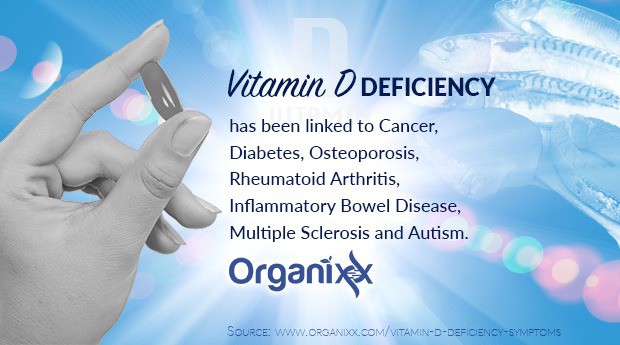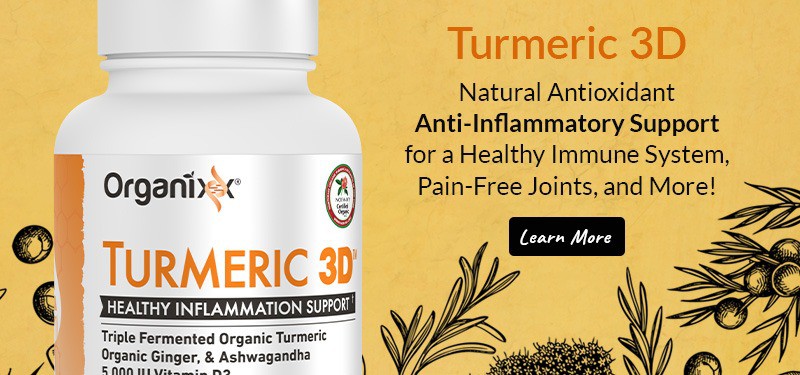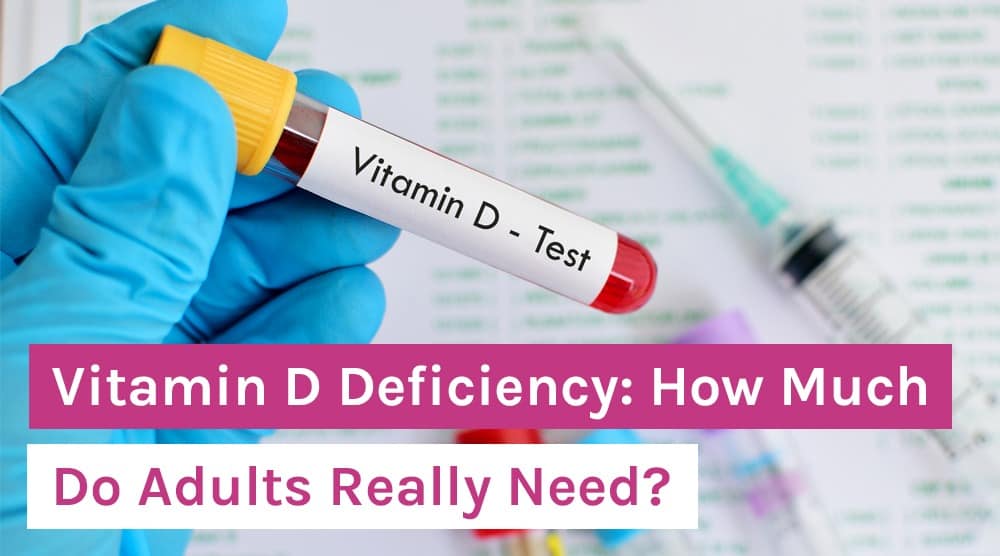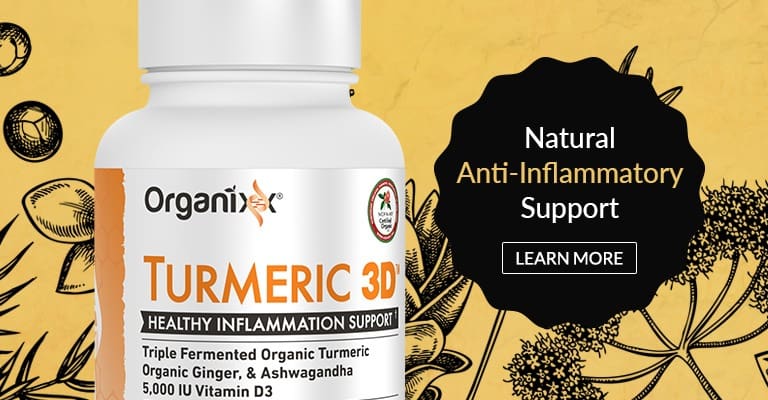Vitamin D Deficiency: How Much Do Adults Really Need?
In a hurry? Click here to read the Article Summary...
Vitamin D is the name given to a group of fat-soluble vitamins found in cod liver oil and fatty fish such as salmon, tuna, and mackerel. These vitamins are essential for the absorption of calcium, iron, phosphate, magnesium, and zinc. Cholecalciferol – also known as vitamin D3 – is made by skin cells when ultraviolet rays (specifically UV-B radiation) from sunlight fall on skin.
All forms of vitamin D – from sun exposure, food, and supplements – are not active and must undergo two chemical reactions within your body to get activated.
The first reaction takes place in the liver and converts vitamin D to 25-hydroxyvitamin D. This form of vitamin D is used to determine a person’s vitamin D status. The second chemical reaction takes place in the kidneys to make the active form, known as 1,25-dihydroxyvitamin D.
Vitamin D helps to maintain blood levels of calcium and phosphate, ensuring that bones are mineralized and healthy. According to the National Institutes of Health (NIH), “Without sufficient vitamin D, bones can become thin, brittle, or misshapen.”
How Does Vitamin D Deficiency Occur?
Vitamin D deficiency happens when consumption is lower than recommended levels, exposure to sunlight is limited, the kidneys don’t convert 25-hydroxy vitamin D to its active form, or when absorption from the gut is not enough.
As vitamin D is commonly added to milk products, having a milk allergy or lactose intolerance – and practicing ovo-vegetarianism and veganism (where no dairy is consumed) can also lead to lower levels of vitamin D.
Common Signs of Vitamin D Deficiency
One of the classic symptoms of vitamin D deficiency is head sweating. Excessive sweating in newborns is considered to be a common, early symptom of vitamin D deficiency.
Another symptom of vitamin D deficiency in children is rickets, in which bone tissue doesn’t mineralize properly, leading to bone softness and skeletal deformities.
Fortification of milk with vitamin D has made rickets a rare disease in the U.S. today. However, using excessive sunscreen and spending a lot of time indoors with limited sun exposure as well as genetic differences in metabolism can still lead to rickets in children today.
Vitamin D Deficiency in Adults: How Much Do You Need?
A common symptom of vitamin D deficiency in adults is osteomalacia – a condition in which bones become soft and there is aching, throbbing bone pain. This is a result of impaired bone metabolism due to inadequate levels of phosphate, calcium, and vitamin D. Another symptom is muscle weakness.
According to the Mayo Clinic, Vitamin D deficiency is an under-diagnosed condition that has now been associated with a higher risk of type 1 diabetes, cardiovascular disease, certain cancers, cognitive decline, depression, pregnancy complications, autoimmunity, and allergy.
In their 2013 report, the Mayo Clinic researchers also reported that low levels of vitamin D during pregnancy and infancy appear to increase susceptibility to schizophrenia, type 1 diabetes, and multiple sclerosis (MS) in later life.
While there is general consensus that too little vitamin D is detrimental, there is an ongoing debate about the levels of 25-hydroxyvitamin D needed for optimum health, especially bone health.
A committee of the Institute of Medicine in Washington, D.C. agreed that people are at risk of vitamin D deficiency at levels of 25-hydroxy vitamin D that are less than 30 nanomoles per liter (nmol/L) or 12 nanograms per milliliter (ng/mL). Further, the committee stated that people are at risk for inadequacy at levels ranging from 30-50 nmol/L or 12-20 ng/mL.
According to the Institute, everyone has “sufficient” vitamin D at levels equal to or greater than 50 nmol/L or 20 ng/mL. However, blood levels of 25-hydroxy vitamin D more than 125 nmol/L or 50 ng/mL have been linked to potential adverse effects.
In 2011, The Endocrine Society stated that the desirable blood level of 25-hydroxyvitamin D is greater than 75 nmol/L (30 ng/mL) for achieving optimal effects on calcium, bone, and muscle metabolism.
To attain these levels, they recommend 1,500-2,000 International Units (IU) daily of supplemental vitamin D as the Recommended Dietary Allowance (RDA) for adults and 1,000 IU daily for children and adolescents.
However, as later developments show, this recommendation is off… and by a very large margin, too.
The “Mistaken” Recommended Daily Allowance (RDA) for Vitamin D?
Researchers at UC San Diego and Creighton University have challenged the RDA for vitamin D recommended by the National Academy of Sciences (NAS) Institute of Medicine (IOM). According to the university researchers, NAS-IOM got their math wrong and underestimated the RDA by a staggering factor of ten!
According to Dr. Cedric F. Garland, Adjunct Professor at UC San Diego’s Department of Family Medicine and Public Health,
“The error has broad implications for public health regarding disease prevention and achieving the stated goal of ensuring that the whole population has enough vitamin D to maintain bone health.”
Robert Heaney, MD, of Creighton University, further wrote:
“We call for the NAS-IOM and all public health authorities…to designate, as the RDA, a value of approximately 7,000 IU/day from all sources.”
This revised recommendation is well below 10,000 IU/day, the designated safe upper limit for teens and adults.
Who’s at Risk for Vitamin D Deficiency?
Getting enough vitamin D from dietary sources alone is difficult. Consuming fortified foods and sufficient exposure to sunlight are both essential for avoiding symptoms of vitamin D deficiency. Dietary supplements may also be necessary.
The following situations can lead to vitamin D deficiency:
- Breastfeeding – vitamin D requirements cannot be met by human milk alone. Most cases of nutritional rickets take place among young, breastfed African Americans. The American Academy of Pediatrics (AAP) recommends that exclusively and partially breastfed infants be supplemented daily with 400 IU of vitamin D.
- Age – older adults are at increased risk of
 developing vitamin D insufficiency because their skin cannot synthesize vitamin D as efficiently as they age, they are likely to spend more time indoors, and they may not consume enough of it in their diet. It is estimated that as many as half of the older adults in the U.S. with hip fractures could be suffering from vitamin D deficiency.
developing vitamin D insufficiency because their skin cannot synthesize vitamin D as efficiently as they age, they are likely to spend more time indoors, and they may not consume enough of it in their diet. It is estimated that as many as half of the older adults in the U.S. with hip fractures could be suffering from vitamin D deficiency. - Limited sun exposure – homebound people, men and women who wear long robes and head coverings for religious reasons, and people with occupations that limit their sun exposure are unlikely to obtain enough vitamin D from sunlight.
- Dark skin – higher levels of melanin significantly reduce the skin’s ability to produce vitamin D from sunlight. However, it is not clear whether lower blood levels of 25-hydroxyvitamin D in people with dark skin have the same health consequences that it does in lighter-skinned people.
- Inflammatory bowel disease (IBD) and other conditions causing fat malabsorption – because vitamin D is fat-soluble, its absorption depends on the gut’s ability to absorb dietary fat. Individuals who cannot properly absorb dietary fat – because of liver disease, cystic fibrosis, celiac disease, Crohn’s disease, and ulcerative colitis – will require vitamin D supplementation.
- Obesity – a body mass index (BMI) equal to or greater than 30 is associated with lower blood 25-hydroxyvitamin D levels. Obese people need to consume more vitamin D, since subcutaneous fat binds and stores 25-hydroxyvitamin D, delaying its release into the blood.
Is Osteoporosis a Symptom of Vitamin D Deficiency?
More than 40 million adults in the U.S. have or are at risk of developing osteoporosis, in which low bone mass and deterioration of bone tissue increase bone fragility and significantly increase fracture risk. Along with inadequate calcium consumption, insufficient vitamin D contributes to osteoporosis by reducing calcium absorption.
Maintaining proper storage levels of vitamin D supports bone strength, which in turn can help to prevent osteoporosis in older adults, individuals who have difficulty exercising, and postmenopausal women.

Turmeric 3D from Organixx provides you one of the most “bioavailable” forms of turmeric due to its unique fermentation process. This means your body experiences the maximum benefits of the purest, most potent turmeric available!

 Sources:
Sources:
Article Summary
Vitamin D is the name given to a group of fat-soluble vitamins found in cod liver oil and fatty fish such as salmon, tuna, and mackerel.
All forms of vitamin D – from sun exposure, food, and supplements – are not active and must undergo two chemical reactions within your body to get activated. The first takes place in the liver and the second in the kidneys.
Vitamin D helps to maintain blood levels of calcium and phosphate, ensuring that bones are mineralized and healthy.
Vitamin D deficiency happens when consumption is lower than recommended levels, exposure to sunlight is limited, the kidneys don’t convert 25-hydroxy vitamin D to its active form, or when absorption from the gut is not enough.
Vitamin D deficiency is an under-diagnosed condition that has now been associated with a higher risk of type 1 diabetes, cardiovascular disease, certain cancers, cognitive decline, depression, pregnancy complications, autoimmunity, and allergy.
The following situations can lead to vitamin D deficiency:
- Breastfeeding
- Age
- Limited sun exposure
- Dark skin
- Inflammatory bowel disease (IBD) and other conditions causing fat malabsorption
- Obesity
Maintaining proper storage levels of vitamin D supports bone strength which in turn can help to prevent osteoporosis.






Good quality supplement will do the trick - why suggest we consume dairy that has been supplemented with vitamin D?? SO many independent (i.e. not subsidized by the dairy industry) studies show that consumption of dairy (which is milk meant for baby cows) is shown to have a direct correlation to osteoporosis! The consumption of animal products is directly linked to heart disease, diabetes, and cancer. Animals are a "middle man" for what we really need - vitamins and minerals - think about it - where do the animals get vitamins and minerals from? Plants! Eat primarily plant based - better for you, the planet and the animals.
Thank you for your comment, Sue. We are happy to hear that you are doing very well in a plant-based diet!
There’s an excellent technological breakthrough that is neither nutritional... nor a herb nor a vitamin nor a mineral nor anything you may have heard of. Many scientists are hailing it the greatest medical breakthrough of our life time
Email me if you want more info
Saving many many lives !?❤️
Hi
Can share more infor please?
D3 helps with mild to moderate depression and has been an important part of my supplement plan to reduce the pain of severe osteoarthritis. At higher doses, it really helped me reduce the pain.
Good article !
I take blood pressure medication and aspirin, how will this affect me r interact with this vitamin?